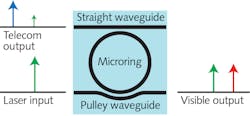Silicon nanophotonic OPO produces visible and telecom wavelengths
Integrated silicon and other photonic circuits benefit from a wealth of passive optical devices such as modulators, splitters, and so on, but suffer from a shortage of active devices—especially coherent emitters. The usual solution, hybrid integration, adds lasers made from III-V semiconductors grown on or bonded to the silicon photonic circuit. These lasers typically emit in the near-infrared (near-IR). However, numerous applications, including spectrometers, metrology systems, and sensors, would benefit from silicon-photonic emitters generating coherent visible light. Researchers from the National Institute of Standards and Technology (NIST; Gaithersburg, MD and Boulder, CO), the University of Maryland (College Park, MD), Carnegie Mellon University (Pittsburgh, PA), the University of Colorado (Boulder, CO), and the Joint Quantum Institute, NIST/University of Maryland (College Park, MD) have filled this need by using silicon nanophotonics on a silicon nitride platform to create visible light via widely separated optical parametric oscillation (OPO).
The device, which is based on an OPO that uses up to two pump photons for each signal/idler pair that is generated, produces signal and idler light at 700 nm and 1300 nm wavelengths, respectively, from a 900 nm pump. A silicon nitride microring 23 µm in diameter with a waveguide width of 1160 nm and height of 510 nm fabricated on a silicon dioxide substrate, when optically pumped, generates signal and idler light via cavity-enhanced degenerate four-wave mixing (dFWM); the signal and idler light have frequencies widely separated from the input pump. Two waveguides, straight and bent “pulley,” outcouple the idler and visible wavelengths, respectively. The OPO operates at a threshold power of 0.9 ± 0.1 mW, which the researchers say is more than 50X lower than previous similar devices. In addition, if the often-used near-IR wavelengths of 780 and 1550 nm are desired, a slightly different version of the OPO can produce them with a pump threshold power of 1.3 ± 0.1 mW. Reference: X. Lu et al., Optica (2020); https://doi.org/10.1364/optica.6.001535.
About the Author
John Wallace
Senior Technical Editor (1998-2022)
John Wallace was with Laser Focus World for nearly 25 years, retiring in late June 2022. He obtained a bachelor's degree in mechanical engineering and physics at Rutgers University and a master's in optical engineering at the University of Rochester. Before becoming an editor, John worked as an engineer at RCA, Exxon, Eastman Kodak, and GCA Corporation.

